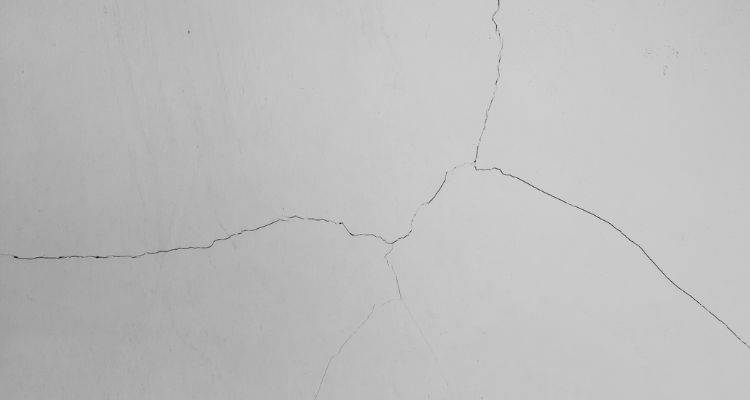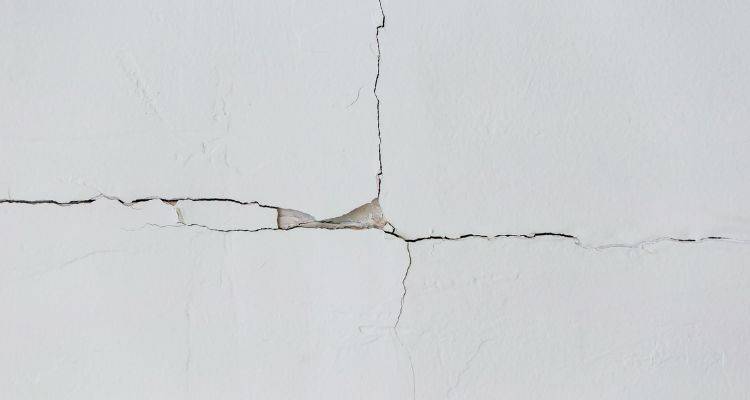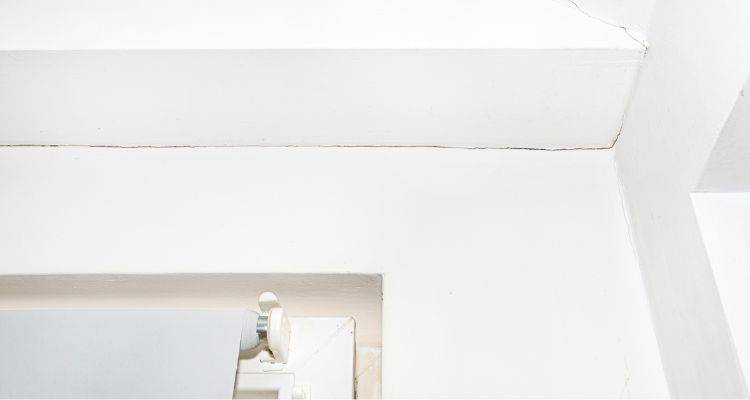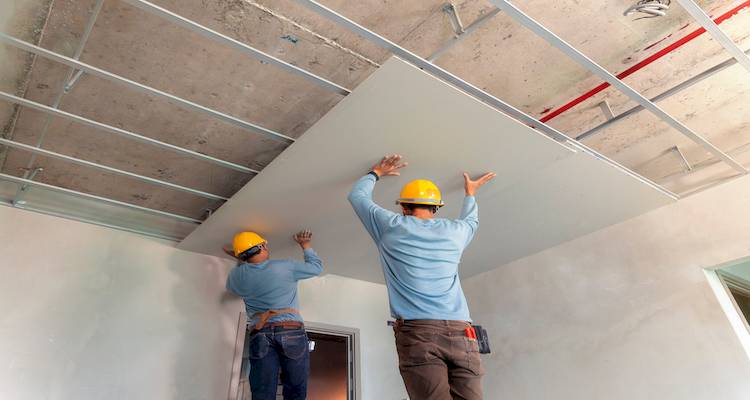Ceiling Replacement Costs
- The average cost to replace a ceiling is around £500.
- The job will take approximately 1 to 2 days to complete.
- A complete pricing breakdown which includes cost factors you need to consider and what such a task usually involves.
- How long the job should approximately take and a general overview of what types of ceiling repair (or replacement) work can be performed.
- How to find and hire a ceiling specialist.
Want to find out the cost to replace a ceiling?
On average, it costs £400 to £1,000 to replace or repair a ceiling.
Perhaps you've got holes in the ceiling, or your ceiling is bowing and need to know what your options are?
So, how will this cost guide help you?
In this guide, we'll discuss all the ins and outs of replacing a ceiling or ceiling repair, and all the costs you need to consider, so you know exactly what you're paying for!
Just need a quick quote?
We have a wide range of ceiling specialists ready to offer you a free quote!
Let's take a more detailed look at the costs below...

£500
Table of Contents
- How Much Does it Cost to Repair a Ceiling?
- Supply Only Costs
- Additional Costs
- Labour Costs and Timescales
- Cost Factors of Ceiling Repairs or Replacement
- Can I Repair or Replace a Ceiling Myself?
- Building Regulations & Planning Permission for Replacing or Repairing a Ceiling
- Types of Ceiling Repairs
- How to Identify Types of Ceiling Cracks
- Hiring Contractors to Replace or Repair a Ceiling Checklist
- FAQs
- Sources
How Much Does it Cost to Repair a Ceiling?
The average cost to replace a ceiling is around £400 to £1,000. The actual price you pay will depend on several factors, including the type of ceiling that is being installed and the size of the room in which it's being installed.
When hiring a contractor to repair or replace your ceiling, you can expect them to charge around £150 to £200 per day. With this in mind, you should budget depending on the number of contractors that you need and how long the work is expected to take.

The size of the ceiling will affect the overall cost of the repair or replacement. The size will also affect the length of time that it takes to complete the repair or replacement. The material of the ceiling will also affect the cost. If it is made from plasterboard, then the work will be much quicker.
Older ceilings may be more difficult to repair or replace as they will be more delicate. The replacement price for this type of job will likely be higher as the work will be more challenging to complete and will often take longer. Some ceilings like this may also require specialist expertise.
Before having your ceiling repaired or replaced, a contractor will often need to come out and do an inspection to see the extent of the damage. At this stage, they will be able to give you a good idea of the work that will need to be carried out as well as an estimate of the costs that will be involved.
Are hairline cracks in an Artex ceiling something to be concerned about. They have, apparently been there for years and would Polyfilla work?
Ceiling Repair Prices
Below is a list of typical ceiling repair and replacement job costs:
| Type of Ceiling Repair | Cost Type | Cost of Job |
|---|---|---|
| Full ceiling replacement | Per project | £400 – £1,000 |
| Small patch and repair work | Per project | £150 – £200 |
| Remedial simple repairs | Per m² | £5 – £15 |
| Plaster a ceiling | Per project | £200 – £1,150 |
| Water leak ceiling repair | Per project | £1,400 – £1,700 |
Supply Only Costs
The cost for supplies will depend on the extent of the job and the materials used. Plasterboard sheets are usually 2400mm x 1200mm in size and come in a variety of different thicknesses and variations. A typical standard plasterboard piece that is 12.5mm thick will usually cost around £6 to £7.
Below is a list of additional tools and materials that you may need to repair or replace a ceiling along with their average costs:
| Material or Tool Type | Average Cost |
|---|---|
| Drywall screws | £5 – £10 |
| Timber batten | £2 – £6 |
| Scrim tape | £5 – £6 |
| Bag of plaster (25kg) | £5 – £10 |
| Plastic sheeting | £3 – £5 |
| Tape measure | £5 – £30 |
| Wood saw | £5 – £20 |
| Plastering trowel | £8 – £80 |
| Pencil | £2 – £5 |
| Work platform/ladder | £60 – £200 |
| Spirit level | £10 – £20 |
| Stanley knife | £5 – £10 |
| Drill with screwdriver function | £25 – £200 |
You may also need to buy some safety gear for this type of work, such as safety goggles (£2 to £15) and dust masks (£1 to £5 each).
Additional Costs
There are a number of additional costs that you may need to think about when it comes to repairing or replacing the ceiling. Below is a list of the other expenses that may come up with these types of jobs:
| Type of Additional Cost | Average Cost |
|---|---|
| Painting | £300 – £500 |
| Light fittings | £80 – £120 |
| Re-decorating the room | £450 – £650 |
| Plaster walls | £150 – £200 |
| Repair/replace electrical work | £30 – £200 |
The cost of painting a bedroom is around £300 to £500, depending on the size of the room and the paint chosen.
If you need your walls plastered before this stage, re-plastering costs £150 to £200.
New light fittings cost between £80 to £120, depending on the fittings you choose and the ease of access to the installation area.
Labour Costs and Timescales
A ceiling repair or replacement will usually need the work of a plasterer or a labourer. A plasterer will usually charge around £150 to £200 per day, and a labourer will usually charge around £80 to £100 per day.
A full ceiling replacement will usually take 1 to 2 days to complete depending on the size of the room. The work will often require 2 contractors to complete the job.
Small ceiling repairs can often be completed within a couple of hours, and so you may be able to pay based on an hourly rate. This rate will usually be around £15 to £20.
Those based in London can expect to pay around £50 to £100 more per day or £5 to £15 more per hour for the cost of labour than those based in the north or other parts of the UK.
Cost Factors of Ceiling Repairs or Replacement
Several factors may affect the cost of a ceiling repair or replacement. Below is a list of the different things that may affect the overall cost of this type of job:
Type of Job
If a full ceiling replacement is needed, you can expect this to cost considerably more than a small repair as it will take much longer. A full ceiling replacement costs around £400 to £1,000, whereas small patch and repair work will usually cost around £150 to £200.
Size of Ceiling
Larger ceilings may cost considerably more to replace than smaller ceilings. This is due to the extra materials and time needed to complete the job. The cost of labour will increase according to the size of the replacement or repair required.

Extent of Damage
The extent of the damage will also affect the cost. Some jobs will require a lot more work than others, and so the labour costs can really add up. You may also find that additional work needs to be completed once the affected area has been opened up and adequately examined. This is most common with water damaged ceilings.
Location of Property
The location of your property can affect the overall costs that you can expect to pay for a ceiling repair or replacement. Those based in London can expect to pay around £50 to £100 more per day or £5 to £15 more per hour for the cost of labour than those based in the north or other parts of the UK.
We recently got a small extension roof insulated with 100mm insulation boards and plasterboards on top. The guy doing the work said we could heighten the ceiling, by removing the collars that tied the two rafter sides together. Job is less than 5 months old and cracks have started appearing in the ceiling. Will our ceiling eventually collapse?
Can I Repair or Replace a Ceiling Myself?
Most DIY enthusiasts will be capable of completing a ceiling repair or replacement, although a little bit of knowledge will be needed to carry out the work successfully.

When completing this type of work as a DIY project, it's essential to consider safety first, especially when removing a ceiling. You should also consider the type of safety equipment that you will need to carry out the work safely.
Since replacing or repairing a ceiling can sometimes be quite a big job and often requires more than one pair of hands, it is usually recommended that you choose an appropriate contractor for the work.
Building Regulations & Planning Permission for Replacing or Repairing a Ceiling
If your property is a listed building and you need to carry out a ceiling repair or replacement, you will need to get consent before you start the work. You will also have to replace the ceiling on a like for like basis. Listed building consent is exempt from any planning permission application fees.
If the work that needs to be carried out is due to a roof leak and you need extensive repairs on the roof, then you may need to get building control approval. Any work that involves more than 25% of the roof must be notified to the building control department of your local authority. The cost of these types of planning applications is usually around £200.
Types of Ceiling Repairs
There are many different types of ceiling repairs. Below is a list of the most common types of ceiling repair in UK homes and the pros and cons to each type of repair:
Water Damage Repair Cost
Many ceilings require a water damage repair due to leaking pipes or a leaking roof. The damaged part of the ceiling is usually cut out and replaced, and then the area is re-decorated so that it matches the rest of the ceiling. This type of repair will typically cost, on average, around £30 to £40 per square metre.
Pros
- ✔ Water damaged ceilings are often weak and could collapse
- ✔ Water damage will become increasingly unsightly
- ✔ Damp areas may result in mould growth, which can be bad for your health
Cons
- ✖ The repaired area may stand out from the rest of the ceiling
- ✖ Removing the damaged area could result in more damage if not done correctly
- ✖ It will usually require the work of a professional
Hairline and Settlement Crack Repairs Cost
Cracks should be observed over time to see if they are increasing in size or numbers to determine their cause.

Once you know the reason for the cracks, you can then appropriately repair them. The cost for this type of repair is usually around £10 to £20 per square metre.
Pros
- ✔ It restores the aesthetic of the ceiling
- ✔ You can prevent the cracks from getting worse and potentially causing further damage
- ✔ Can sometimes be as easy as covering with flexible paint
Cons
- ✖ You may repair too soon and start to notice more cracks appearing in the future
- ✖ Small cracks can sometimes be frustrating
- ✖ Filling cracks may be unsightly
Peeling Paint Repair Cost
Peeling paint may be caused by water damage or badly prepared plaster before decorating. The cause should be identified before you carry out any repair work on peeling paint. The cost to repair peeling paint is usually around £100 to £160.
Pros
- ✔ Peeling paint is very unattractive, and repairs will make the ceiling look much more pleasing to the eye
- ✔ If the underlying cause is dampness in the ceiling, then you can be alerted of a previously unknown issue
- ✔ It can instantly improve the look of a room
Cons
- ✖ Peeling paint may be caused by damp, which can be a costly repair job
- ✖ You will usually need to repair the whole ceiling so that it all matches
- ✖ Stripping away flaking paint can be a very messy job
I have a lath and plaster ceiling that has been wallpapered and painted over, the paper is peeling and it looks awful. How much would you charge to remove it and replace it? It is 3.5m by 5m, and 2.5m high.
How to Identify Types of Ceiling Cracks
There are lots of different types of ceiling cracks in the UK - here's what you need to know to identify them in your own home:
Hairline Ceiling Crack
Hairline cracks are the least concerning types of ceiling cracks as they're usually superficial, indicating no structural damage, and are less than 1mm in width.

Commonly found at the corners of ceilings, hairline cracks can be caused by:
- House settling, most common in newly-built houses or houses that have been recently renovated with fresh coats of paint.
- Installation of new fixtures, such as light fittings.
- Changes in temperature.
Hairline cracks can be fixed with a thin layer of caulk and a fresh coat of paint. If the cracks become wider than 1mm or keep coming back despite being repaired, call in a ceiling repairs professional for a second opinion.
Spiderweb Ceiling Crack
Spiderweb cracks look as their name suggests, with a defined centre point that spreads outwards to create a spiderweb shape. Like hairline cracks, spiderweb cracks can also be cosmetic - but they can also alert you to structural issues.

These ceiling cracks can be cause for concern if they:
- Appear suddenly and increase in size rapidly, which can mean there's an excessive load on the ceiling or possible foundation movement.
- Are discoloured or have dampness in and around them, as this can signal leaks from pipes, your roof, or other trapped moisture.
The bottom line? If you spot a spiderweb crack that's growing in size and appears to be getting worse, it's best to get a professional to take a look to find the root cause and carry out a ceiling repair.
Straight Ceiling Crack
These ceiling cracks form along plasterboard joins and beams and run in a straight line. Straight line cracks are mostly due to shrinkage during drywall installation.

If the straight line cracks are hairline in nature, they are most often cosmetic issues and can be remedied with re-painting.
However, if they are widening near beams, are over 5mm wide, or appear in conjunction with discolouration and sagging, it can indicate an issue with moisture or water damage, which needs prompt attention.
Discoloured Ceiling Crack
Discoloured ceiling cracks tend to mean there's an issue with trapped moisture in your ceiling, either active or historic. You can identify discolouration by looking out for brown, yellow, or orange-coloured stains that appear around a crack.

The causes for discolouration around a ceiling crack can be:
- Water leaks from pipes, damage to your property's roof, or faulty plumbing.
- Condensation build-up due to poor bathroom or loft space ventilation.
- Mould growth from persistent, unresolved moisture issues.
Water damage can be devastating, causing ceilings to cave in and causing flooding issues inside the home if left untreated. If you touch the discoloured area and it's damp or cold, it's most likely an active leak, and urgent attention is needed before the issue progresses.
You may also get discolouration around ceiling cracks from old water damage. In these cases where the issue has been fixed, it's simply a cosmetic ceiling repair to remove the discolouration if you're sure no moisture issues persist.
Hiring Contractors to Replace or Repair a Ceiling Checklist
Below is a checklist of some things that you should consider before choosing someone to repair or replace your ceiling:
- Be sure to obtain at least 3 separate quotes for the job so that you can ensure you're getting a reasonable price.
- Ask for a breakdown of costs on the quotes so that you can be confident that you're getting a fair price for each different element of the job.
- Be sure to get the quote in writing so that you know exactly what you can expect to pay once the ceiling repair or replacement is complete.
- For any payments you make, always get a receipt.
- Ask around for recommendations on good contractors in your local area.
- Find out how much experience the contractor has in repairing or replacing a ceiling.
- Find out what materials the contractor will be using for their work – you don't want to skimp out on quality to save a bit of money upfront. This may result in you having to spend more on repairs in the future.
- Make sure the contractor you hire meets all of the certifications, licensing, and training requirements as needed to repair or replace your ceiling.
FAQs
How do you repair an Artex ceiling?
Artex ceiling repairs are more straightforward than you may think. You can purchase an Artex repair kit from most DIY shops that will cover a range of ceiling repairs.
You should apply a generous coat of this texture using an emulsion brush and blend it into the area to match the existing pattern. You can find guides on YouTube on how to accurately achieve the different types of Artex patterns and textures.
What is the best way to repair a ceiling crack?
Below is a step-by-step guide on how to repair a ceiling crack:
- Widen the crack with a utility knife to remove any weak or crumbling plaster
- Sand the crack to rough up the paintwork
- Wipe the area with a damp cloth and remove any dust
- Apply a layer of grout into the crack
- Use tape the cover the crack
- Lay drywall joining compound along the crack over the tape
- Allow this to dry and then sand the area
- Prime the new surface
- Paint the surface to match the existing ceiling
How do I cover up a water stain on my ceiling?
You should allow the water stain to fully dry and then use a good quality stain block which can be painted over the affected area. Once the stain block is dry, paint over the area to match the rest of the ceiling.
Is a plasterboard ceiling better than lath and plaster?
Plasterboard is much cheaper than lath and plaster. It is also easier to handle, install and repair. However, lath and plaster are more breathable and, therefore, regulate moisture better within the property. So, both types of ceilings have their advantages.
Can I just paint over a crack in the ceiling?
Hairline cracks can be painted over using a particular type of flexible paint. However, wider gaps should be filled with an appropriate filler before they are painted over.
What's the worst type of ceiling crack?
Ceiling cracks that appear quickly and rapidly deepen or widen are cause for concern. If your ceiling is bowing or sagging, this can mean there is an excessive load on the ceiling or a leak that could cause the ceiling to collapse.
How long should ceilings last for?
A well-maintained ceiling can last in excess of 75 years. Keeping on top of ceiling repairs, cracks, and moisture as and when the issues arise is key to a long-lasting ceiling.
Sources
https://earlyexperts.net/costs-guides/how-to-fix-cracks-in-ceilings/









